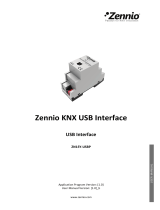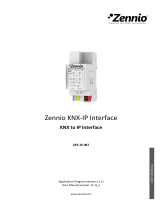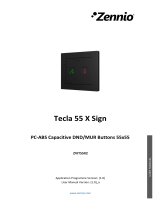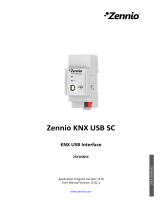Page is loading ...

IDAC
Instalación empotrada en puerta
ZVIIDAC Manual de Instalación
© Zennio Avance y Tecnología S.L. Ed. 3 Para más información www.zennio.com Pág. 1 / 8
MONTAJE DE LA ARMADURA PARA EL MARCO Y CONEXIÓN AL BUS KNX
Partes de la armadura para el marco
1 Conectar el cable del bus KNX y la clema del conector del estado
de la puerta (opcional) e introducir la armadura dentro del marco.
2 Fijar la armadura al marco, ajustando los dos tornillos.
3 Montaje de la armadura finalizado.
*Nota: En las imágenes se muestra un montaje para puerta con apertura hacia la izquierda. Para puertas con
apertura hacia la derecha el montaje es simétrico.
(Ver https://www.zennio.com/download/idac_technical_note_door_direction_din_107_es para la descripción
de la apertura hacia derecha/izquierda).
4
5
3
2
1
1. Marco de la puerta
2. Tornillo (2x)
3. Armadura (1x)
4. Conector del estado
de la puerta
5. Conector del bus KNX
2x
(2)
(2) Tornillo para madera
Ø3,5 x 16 – avellanado

© Zennio Avance y Tecnología S.L. Ed. 3 Para más información www.zennio.com Pág. 2 / 8
MONTAJE DE LA CERRADURA EMPOTRADA EN LA PUERTA
Partes de la cerradura
* Vista exterior
1 Introducir la cerradura en el hueco de la puerta, pasando el cable
de conexión hasta el mecanizado superior de la puerta y sacando el
cable por la parte interior como se muestra en el detalle.
2 Con la cerradura insertada, colocar el cilindro en el orificio inferior
(por el exterior de la puerta) y fijarlo con el tornillo del cilindro (con la
llave colocada y girada).
*Nota: En las imágenes se muestra un montaje para puerta con apertura hacia la izquierda. Para puertas con
apertura hacia la derecha el montaje es simétrico.
(Ver https://www.zennio.com/download/idac_technical_note_door_direction_din_107_es para la descripción
de la apertura hacia derecha/izquierda).
1
11
2
3
6
7
10
4
5
9
8
1. Puerta
2. Cable de la cerradura (1x)
3. Cerradura Zennio (1x)
4. Embellecedor (1x)
5. Tornillo para fijar cerradura (2x)
6. Batería (1x)
7. Tornillo para fijar embellecedor (1x)
8. Tornillo del cilindro (1x)
9. Tapón (1x)
10. Llave del cilindro (1x)
11. Cilindro (1x)
(5)
(5) Tornillo para madera
Ø4 x 20 - avellanado
2x

© Zennio Avance y Tecnología S.L. Ed. 3 Para más información www.zennio.com Pág. 3 / 8
*Nota: En las imágenes se muestra un montaje para puerta con apertura hacia la izquierda. Para puertas con
apertura hacia la derecha el montaje es simétrico.
(Ver https://www.zennio.com/download/idac_technical_note_door_direction_din_107_es para la descripción
de la apertura hacia derecha/izquierda).
3 Con el cilindro fijado, colocar manualmente
el tapón para ocultar el tornillo.
4 Por último, fijar la cerradura y el
embellecedor con ayuda de sus tres tornillos.
5 Montaje de la cerradura finalizado.

© Zennio Avance y Tecnología S.L. Ed. 3 Para más información www.zennio.com Pág. 4 / 8
MONTAJE DE LAS MANILLAS
1 Introducir los cuadradillos por ambos lados de la puerta,
asegurándose de que estos entren hasta el fondo del agujero de
la cerradura (para ello puede ser necesario el uso de un martillo
de Nylon o semejante). Introducir los aislantes plásticos de los
tornillos en los agujeros de la puerta (desde la parte interior) y
cortar el sobrante de cada uno de ellos. Los aislantes plásticos
deben ser cortados con formón.
2 Con los aislantes y cuadradillos instalados, fijar las manillas con los
tornillos recortados (exterior) y los casquillos roscados correspondientes
(interior). Puede ser necesario cortar los tornillos pasantes previamente, para
adaptar su longitud al ancho de la puerta.
*Nota: En las imágenes se muestra un montaje para puerta con apertura hacia la izquierda. Para puertas con
apertura hacia la derecha el montaje es simétrico.
(Ver https://www.zennio.com/download/idac_technical_note_door_direction_din_107_es para la descripción
de la apertura hacia derecha/izquierda).
9
10
11
12
1
2
6
7
8
3
4
5
13
5
1. Manilla (1x)
2. Cuadradillo exterior con
aislante (1x)
3. Tornillos pasantes (2x)
4. Tornillos de fijación (8x)
5. Embellecedor de la
manilla (1x)
6. Tapa de la bocallave (1x)
7. Tornillos de fijación (2x)
8
.
Bocallave
(
1x
)
9. Aislantes de los tornillos
(2x)
10. Cuadradillo interior con
aislante (1x)
11. Manilla (1x)
12. Casquillos roscados (2x)
13. Embellecedor de la
manilla (1x)
* Vista interior
* Vista exterior
P
artes de las
m
anillas
(3)
(3) Tornillo pasante roscado
M4 x 90 - avellanado
(
4
)
(4) Tornillo para madera
Ø3,5 x 16 - avellanado
(7) Tornillo para madera
Ø4 x 20 - avellanado
2x
8x
2x
(7)
(12) Casquillo roscado
M4 x 16 - avellanado
(12)
2
x

© Zennio Avance y Tecnología S.L. Ed. 3 Para más información www.zennio.com Pág. 5 / 8
3 Fijar ambos conjuntos, atornillando los ocho tornillos de
fijación directamente en la puerta. Y asegurar la bocallave
utilizando los otros dos tornillos de fijación.
4 Por último, una vez que estén bien fijados todos los elementos, colocar
los embellecedores y la tapa de la bocallave, a presión.
Nota: Asegurarse que la muesca de la tapa de la bocallave queda orientada
hacia abajo.
5 Montaje de las manillas finalizado.
*Nota: En las imágenes se muestra un montaje para puerta con apertura hacia la izquierda. Para puertas con
apertura hacia la derecha el montaje es simétrico.
(Ver https://www.zennio.com/download/idac_technical_note_door_direction_din_107_es para la descripción
de la apertura hacia derecha/izquierda).

© Zennio Avance y Tecnología S.L. Ed. 3 Para más información www.zennio.com Pág. 6 / 8
MONTAJE DE LOS MÓDULOS ELECTRÓNICOS
Partes de los módulos electrónicos
1 Conectar el cable de interconexión entre módulos (15 pines)
al módulo electrónico exterior e introducir el módulo en el hueco
correspondiente, pasando el cable hacia el interior de la puerta.
Aproximar la chapa de fijación por el interior, pasando por su
orificio tanto el cable de la cerradura como el de interconexión.
Asegurarse de que la rosca para el tornillo de seguridad quede en
la parte inferior.
2 Cortar los tornillos pasantes para adaptarlos al ancho de la puerta y
utilizarlos para atornillar la chapa de fijación al módulo electrónico exterior
previamente insertado en la puerta.
*Nota: En las imágenes se muestra un montaje para puerta con apertura hacia la izquierda. Para puertas con
apertura hacia la derecha el montaje es simétrico.
(Ver https://www.zennio.com/download/idac_technical_note_door_direction_din_107_es para la descripción
de la apertura hacia derecha/izquierda).
2
6
5
4
7
1
3
1. Módulo electrónico
exterior (1x)
2. Cable de interconexión
entre módulos (1x)
3. Cable de la cerradura
4. Chapa de fijación (1x)
5. Tornillos pasantes (4x)
6. Módulo electrónico
interior (1x)
7. Tornillo de seguridad (1x)
* Vista interior
* Vista exterior
* Vista posterior
(5)
(5) Tornillo pasante roscado
M4 x 90 - avellanado
(7)
(7) Tornillo de seguridad
M2,5 x 4 - Torx
4x
1x

© Zennio Avance y Tecnología S.L. Ed. 3 Para más información www.zennio.com Pág. 7 / 8
3 Conectar el cable de interconexión proveniente del módulo exterior en el conector inferior de 15 pines (grande) del módulo interior.
Posteriormente, conectar el cable proveniente de la cerradura en el conector superior de 12 pines (pequeño).
*Nota: Comprobar que la conexión del cable tiene la polaridad correcta (2 pequeñas muescas hacia arriba como se muestra en la imagen).
4 Una vez que la chapa de fijación está bien atornillada y ambos cables se encuentran correctamente conectados al módulo interior, introducir
suavemente la parte superior del módulo interior en la pestaña de la chapa de fijación hasta que haga click (es necesario girar levemente el
dispositivo como se muestra en la secuencia de imágenes) y una vez encajada la pestaña superior, cerrar la parte inferior y poner el tornillo de
seguridad mediante un destornillador Torx.
*Nota: En las imágenes se muestra un montaje para puerta con apertura hacia la izquierda. Para puertas con
apertura hacia la derecha el montaje es simétrico.
(Ver https://www.zennio.com/download/idac_technical_note_door_direction_din_107_es para la descripción
de la apertura hacia derecha/izquierda).
Cable de interconexión
entre módulos
Cable proveniente de
la cerradura
①
②

© Zennio Avance y Tecnología S.L. Ed. 3 Para más información www.zennio.com Pág. 8 / 8
ANEXO A – REEMPLAZO DE BATERÍA
1 Retirar el embellecedor destornillando sus
tres tornillos.
2 Retirar la batería de su alojamiento. 3 Insertar la nueva batería procurando no
dañar las conexiones.
4 Por último, fijar nuevamente el embellecedor mediante sus tres tornillos.
*Nota: En las imágenes se muestra un montaje para puerta con apertura hacia la izquierda. Para puertas con
apertura hacia la derecha el montaje es simétrico.
(Ver https://www.zennio.com/download/idac_technical_note_door_direction_din_107_es para la descripción
de la apertura hacia derecha/izquierda).

IDAC
In-door, Flush-Mount assembly
ZVIIDAC Assembly instructions
© Zennio Avance y Tecnología S.L. Ed. 3 Further info: www.zennio.com Page 1 / 8
ASSEMBLY OF THE DOOR FRAME PLATE AND KNX BUS CONNECTION
Parts of the door frame plate
1 Connect the KNX bus and the connector of the door status
(optional) and insert the plate into the door frame gap.
2 Fix the plate to the door frame by means of the screws.
3 Door frame plate assembled.
* Note: Images show the assembly for a left-hand door. For right-hand doors the assembly is symmetrical.
(See https://www.zennio.com/download/idac_technical_note_door_direction_din_107_en for left-hand/right-
hand description).
4
5
3
2
1
1. Door frame
2. Screws (2x)
3. Plate (1x)
4. Door status connector
5. KNX bus connector
2x
(2)
(2) Wood screw
Ø3.5 x 16 - countersunk

© Zennio Avance y Tecnología S.L. Ed. 3 Further info: www.zennio.com Page 2 / 8
ASSEMBLY OF THE IN-DOOR, FLUSH-MOUNT ELECTRIC LOCK
Electric lock parts
1 Insert the electric lock into the gap made in the door; the cable must
be passed through the upper hole and it must be recovered from the
internal side of the door.
2 Once the electric lock is inserted, place the cylinder into its hole
(from the external part of the door) and fix it using the cylinder screw
(with the key inserted and rotated).
* Note: Images show the assembly for a left-hand door. For right-hand doors the assembly is symmetrical.
(See https://www.zennio.com/download/idac_technical_note_door_direction_din_107_en for left-hand/right-
hand description).
1
11
2
3
6
7
10
4
5
9
8
1. Door
2. Electric lock cable (1x)
3. Zennio electric lock (1x)
4. Cover (1x)
5. Screw for electric lock (2x)
6. Battery (1x)
7. Screw for cover (1x)
8. Cylinder screw (1x)
9. Cap (1x)
10. Cylinder key (1x)
11. Cylinder (1x)
* External view
(5)
(5) Wood screw
Ø4 x 20 - countersunk
2x

© Zennio Avance y Tecnología S.L. Ed. 3 Further info: www.zennio.com Page 3 / 8
* Note: Images show the assembly for a left-hand door. For right-hand doors the assembly is symmetrical.
(See https://www.zennio.com/download/idac_technical_note_door_direction_din_107_en for left-hand/right-
hand description).
3 Once the cylinder is fixed, place the cap of
the cylinder screw.
4 Finally, fix the electric lock and the cover
by means of the three screws.
5 Electric lock assembled.

© Zennio Avance y Tecnología S.L. Ed. 3 Further info: www.zennio.com Page 4 / 8
HANDLES ASSEMBLY
* Note: Images show the assembly for a left-hand door. For right-hand doors the assembly is symmetrical.
(See https://www.zennio.com/download/idac_technical_note_door_direction_din_107_en for left-hand/right-
hand description).
1 Insert the square spindles in both sides of the door, making
sure they enter as far as they will go into the lock hole (it might be
necessary to use a Nylon hammer or similar). Insert the screw
isolators in the holes (from the internal side of the door) and, if it is
necessary, cut the excess in order to adapt their length to the door
thickness. The isolators should be cut with a chisel.
2 Once the screw isolators and square spindles are installed, fix the
handles with the through-screws and the threaded bushings. It may be
necessary to previously cut the through-screws to adapt their length to the
door thickness.
9
10
11
12
1
2
6
7
8
3
4
5
13
5
1. Handle (1x)
2. External square spindle with
isolator (1x)
3. Through-screws (2x)
4. Fixing screws (8x)
5. Handle base cover (1x)
6. Keyhole cap (1x)
7. Fixing screws (2x)
8. Keyhole (1x)
9. Screw isolators (2x)
10. Internal square spindle
with isolator (1x)
11. Handle (1x)
12. Threaded bushings (2x)
13. Handle base cover (1x)
* Internal view
* External view
Handle parts
(3)
(3) Threaded through-screw
M4 x 90 - countersunk
(4)
(4) Wood screw
Ø3.5 x 16 - countersunk
(7) Wood screw
Ø4 x 20 - countersunk
2x
8x
2x
(7)
(12) Threaded bushing
M4 x 16 - countersunk
(12)
2x

© Zennio Avance y Tecnología S.L. Ed. 3 Further info: www.zennio.com Page 5 / 8
* Note: Images show the assembly for a left-hand door. For right-hand doors the assembly is symmetrical.
(See https://www.zennio.com/download/idac_technical_note_door_direction_din_107_en for left-hand/right-
hand description).
3 Fix both handles by screwing the eight fixing screws directly
to the door. Place the keyhole around the cylinder and fix it with its
two fixing screws.
4 Finally, once all the parts are fixed, place the covers to the keyhole and
handle bases by pressing them.
Note: Please, check that the notch of the keyhole cap is facing downwards.
5 Handles assembly finished.

© Zennio Avance y Tecnología S.L. Ed. 3 Further info: www.zennio.com Page 6 / 8
ELECTRONIC MODULES ASSEMBLY
Electronic module parts
1 Connect the module interconnection cable (15 pins) to the
external electronic module. Place the external module in its
position, passing its cable through the door hole. Place the fixing
plate near the internal part of the door and pass the
interconnection cable and the electric lock cable though the plate
hole. The plate must be oriented with the threated-hole for the
security screw facing downwards.
2 Cut the through-screws to adapt their length to the door thickness and
use them to tighten the fixing plate to the external electronic module
previously inserted into the door.
* Note: Images show the assembly for a left-hand door. For right-hand doors the assembly is symmetrical.
(See https://www.zennio.com/download/idac_technical_note_door_direction_din_107_en for left-hand/right-
hand description).
2
6
5
4
7
1
3
1. External electronic
module (1x)
2. 15-pin interconnection
cable (1x)
3. Electric lock cable
4. Fixing plate (1x)
5. Through-screws (4x)
6. Internal electronic module (1x)
7. Security screw (1x)
* Internal view
* External view
*
Rear view
(5)
(5) Threaded through-screw
M4 x 90 - countersunk
(7)
(7) Security screw
M2.5 x 4 - Torx
4x
1x

© Zennio Avance y Tecnología S.L. Ed. 3 Further info: www.zennio.com Page 7 / 8
3 Connect into the 15-pin connector (bigger one) of the internal module the interconnection cable from the external module. Then, connect the
cable coming from the electric lock into the upper 12-pin connector (smaller one).
*Note: Verify that each cable is connected with the correct polarity (there must be 2 small notches in the upper part, like it is shown in the figure).
4 Once the fixing plate is tightened and both cables are connected to the internal module, insert softly the upper part of the internal module in the
upper tab of the fixing plate until it clicks (it is necessary to slightly rotate the device like shown in the image sequence). Then, when the upper part
is fitted, close the lower part and insert the security screw with a Torx screwdriver.
* Note: Images show the assembly for a left-hand door. For right-hand doors the assembly is symmetrical.
(See https://www.zennio.com/download/idac_technical_note_door_direction_din_107_en for left-hand/right-
hand description).
Module
interconnection cable
Cable coming from
the electric lock
①
②

© Zennio Avance y Tecnología S.L. Ed. 3 Further info: www.zennio.com Page 8 / 8
ANNEX A – BATTERY REPLACEMENT
1 Remove the cover by unscrewing the three
screws.
2 Remove the battery from its housing. 3 Insert the new battery making sure not to
damage the connection.
4 Finally, fix the cover by means of the three screws.
* Note: Images show the assembly for a left-hand door. For right-hand doors the assembly is symmetrical.
(See https://www.zennio.com/download/idac_technical_note_door_direction_din_107_en for left-hand/right-
hand description).

IDAC
Installation encastré dans la porte
ZVIIDAC Manuel d'installation
© Zennio Avance y Tecnología S.L. Ed. 3 Pour plus d'information www.zennio.com Page 1 / 8
MONTAGE DE LA TÉTIÈRE DU CADRE DE PORTE SUR LE MONTANT ET CONNEXION AU BUS KNX
Partie de la tétière du cadre de porte sur le
montant
1 Connecter le câble du bus KNX et la borne du connecteur de l'état
de la porte (optionnel) et introduire la tétière dans le cadre.
2 Fixer la tétière du cadre de porte au montant, en ajustant les deux
vis.
3 Montage de la tétière du cadre de porte terminé.
*Note: Sur les images se montre un montage pour porte avec ouverture vers la gauche. Pour portes avec
ouverture vers la droite le montage est symétrique.
(Voir https://www.zennio.com/download/idac_technical_note_door_direction_din_107_fr pour la description
de l'ouverture vers la droite/gauche).
4
5
3
2
1
1. Cadre de la porte
2. Vis (2x)
3. Tétière (1x)
4. Connecteur de l'état de
la porte
5. Connecteur du bus
KNX.
2x
(2)
(2) Vis pour le bois
Ø3,5 x 16 – fraisé

© Zennio Avance y Tecnología S.L. Ed. 3 Pour plus d'information www.zennio.com Page 2 / 8
MONTAGE DE LA SERRURE ENCASTRÉ DANS LA PORTE
Parties de la serrure
* Vue extérieure
1 Introduire la serrure dans le logement de la porte, en passant le
câble de connexion jusqu'à l'usinage supérieur de la porte et en sortant
le câble par la partie intérieure comme montré dans le détail.
2 Avec la serrure insérée, placez le cylindre dans l'orifice inférieur
(par l'extérieur de la porte) et le fixer avec la vis du cylindre (avec la clé
dans son logement et la tourner).
*Note: Sur les images se montre un montage pour porte avec ouverture vers la gauche. Pour portes avec
ouverture vers la droite le montage est symétrique.
(Voir https://www.zennio.com/download/idac_technical_note_door_direction_din_107_fr pour la description
de l'ouverture vers la droite/gauche).
1. Porte
2. Câble de la serrure (1x)
3. Serrure Zennio (1x)
4. Enjoliveur (1x)
5. Vis pour fixer la serrure (2x)
6. Batterie (1x)
7. Vis pour fixer l'enjoliveur (1x)
8. Vis du cylindre (1x)
9. Bouchon (1x)
10. Clé du cylindre (1x)
11. Cylindre (1x)
(5)
(5) Vis pour le bois
Ø3,5 x 20 – fraisé
2x

© Zennio Avance y Tecnología S.L. Ed. 3 Pour plus d'information www.zennio.com Page 3 / 8
*Note: Sur les images se montre un montage pour porte avec ouverture vers la gauche. Pour portes avec
ouverture vers la droite le montage est symétrique.
(Voir https://www.zennio.com/download/idac_technical_note_door_direction_din_107_fr pour la description
de l'ouverture vers la droite/gauche).
3 Avec le cylindre fixé, situé manuellement le
cache pour occulter la vis.
4 Pour terminer, fixer la serrure et
l'enjoliveur au moyen de ses trois vis.
5 Montage de la serrure terminé.

© Zennio Avance y Tecnología S.L. Ed. 3 Pour plus d'information www.zennio.com Page 4 / 8
MONTAGE DES POIGNÉES
1 Introduire les petits carrés des deux côtés de la porte,
assurez-vous de que ceux-ci entrent jusqu'au fond du trou de la
serrure (pour cela il peut-être nécessaire l'utilisation d'un marteau
de nylon ou de quelque chose de semblable). Introduire les
isolants plastiques des vis dans les trous de la porte (depuis la
partie intérieure) et couper ce qui dépasse de chacun d'entre eux.
Les isolants plastiques doivent être coupés avec un ciseau.
2 Avec les isolants et petits carrés installés, fixer les poignées avec les vis
recoupées (extérieur) et les douilles filetées correspondantes (intérieure). Il
peut-être nécessaire de couper les vis passantes au préalable, pour adapter
leur longueur à la largeur de la porte.
*Note: Sur les images se montre un montage pour porte avec ouverture vers la gauche. Pour portes avec
ouverture vers la droite le montage est symétrique.
1. Poignée (1x)
2. Petit carré extérieur avec
isolant (1x)
3. Vis passantes (2x)
4. Vis de fixation (8x)
5. Enjoliveur de la poignée (1x)
6. Rosace d'entrée de la clé de
la serrure (1x)
7. Vis de fixation (2x)
8. Rosace d'entrée de la clé
(1x)
9. Isolants des vis (2x)
10. Petit carré intérieur avec
isolant (1x)
11. Poignée (1x)
12. Douilles filetées (2x)
13. Enjoliveur de la poignée (1x)
* Vue
intérieure
* Vue
extérieure
Parties des poignées
(3)
(3) Vis passante filetée
M4 x 90 - fraisé
(4)
(4) Vis pour le bois
Ø3,5 x 16 – fraisé
(7) Vis pour le bois
Ø3,5 x 20 – fraisé
2x
8x
2x
(7)
(12) Douilles filetées
M4 x 16 - fraisé
(12)
2x
/











